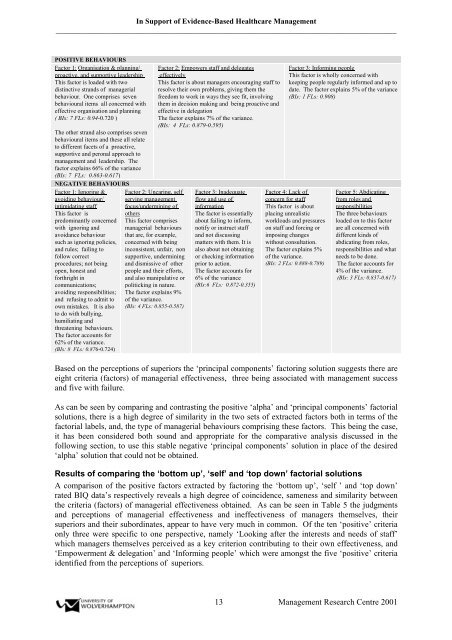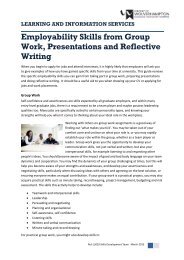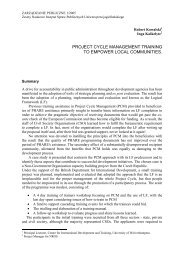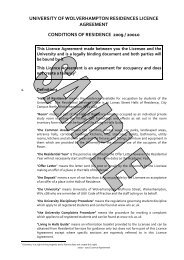In Support of Evidence-Based Healthcare Management: an ...
In Support of Evidence-Based Healthcare Management: an ...
In Support of Evidence-Based Healthcare Management: an ...
- No tags were found...
You also want an ePaper? Increase the reach of your titles
YUMPU automatically turns print PDFs into web optimized ePapers that Google loves.
<strong>In</strong> <strong>Support</strong> <strong>of</strong> <strong>Evidence</strong>-<strong>Based</strong> <strong>Healthcare</strong> <strong>M<strong>an</strong>agement</strong>_________________________________________________________________________________________POSITIVE BEHAVIOURSFactor 1: Org<strong>an</strong>isation & pl<strong>an</strong>ning/proactive, <strong>an</strong>d supportive leadershipThis factor is loaded with twodistinctive str<strong>an</strong>ds <strong>of</strong> m<strong>an</strong>agerialbehaviour. One comprises sevenbehavioural items all concerned witheffective org<strong>an</strong>isation <strong>an</strong>d pl<strong>an</strong>ning( BIs: 7 FLs: 0.94-0.720 )The other str<strong>an</strong>d also comprises sevenbehavioural items <strong>an</strong>d these all relateto different facets <strong>of</strong> a proactive,supportive <strong>an</strong>d peronal approach tom<strong>an</strong>agement <strong>an</strong>d leadership. Thefactor explains 66% <strong>of</strong> the vari<strong>an</strong>ce(BIs: 7 FLs: 0.863-0.617)NEGATIVE BEHAVIOURSFactor 1: Ignoring &avoiding behaviour/intimidating staffThis factor ispredomin<strong>an</strong>tly concernedwith ignoring <strong>an</strong>davoid<strong>an</strong>ce behavioursuch as ignoring policies,<strong>an</strong>d rules; failing t<strong>of</strong>ollow correctprocedures; not beingopen, honest <strong>an</strong>dforthright incommunications;avoiding responsibilities;<strong>an</strong>d refusing to admit toown mistakes. It is alsoto do with bullying,humiliating <strong>an</strong>dthreatening behaviours.The factor accounts for62% <strong>of</strong> the vari<strong>an</strong>ce.(BIs: 8 FLs: 0.876-0.724)Factor 2: Uncaring, selfserving m<strong>an</strong>agementfocus/undermining <strong>of</strong>othersThis factor comprisesm<strong>an</strong>agerial behavioursthat are, for example,concerned with beinginconsistent, unfair, nonsupportive, undermining<strong>an</strong>d dismissive <strong>of</strong> otherpeople <strong>an</strong>d their efforts,<strong>an</strong>d also m<strong>an</strong>ipulative orpoliticking in nature.The factor explains 9%<strong>of</strong> the vari<strong>an</strong>ce.(BIs: 4 FLs: 0.855-0.587)Factor 2: Empowers staff <strong>an</strong>d delegateseffectivelyThis factor is about m<strong>an</strong>agers encouraging staff toresolve their own problems, giving them thefreedom to work in ways they see fit, involvingthem in decision making <strong>an</strong>d being proactive <strong>an</strong>deffective in delegationThe factor explains 7% <strong>of</strong> the vari<strong>an</strong>ce.(BIs: 4 FLs: 0.879-0.595)Factor 3: <strong>In</strong>adequateflow <strong>an</strong>d use <strong>of</strong>informationThe factor is essentiallyabout failing to inform,notify or instruct staff<strong>an</strong>d not discussingmatters with them. It isalso about not obtainingor checking informationprior to action.The factor accounts for6% <strong>of</strong> the vari<strong>an</strong>ce(BIs:6 FLs: 0.872-0.355)Factor 3: <strong>In</strong>forming peopleThis factor is wholly concerned withkeeping people regularly informed <strong>an</strong>d up todate. The factor explains 5% <strong>of</strong> the vari<strong>an</strong>ce(BIs: 1 FLs: 0.908)Factor 4: Lack <strong>of</strong>concern for staffThis factor is aboutplacing unrealisticworkloads <strong>an</strong>d pressureson staff <strong>an</strong>d forcing orimposing ch<strong>an</strong>geswithout consultation.The factor explains 5%<strong>of</strong> the vari<strong>an</strong>ce.(BIs: 2 FLs: 0.888-0.789)Factor 5: Abdicatingfrom roles <strong>an</strong>dresponsibilitiesThe three behavioursloaded on to this factorare all concerned withdifferent kinds <strong>of</strong>abdicating from roles,responsibilities <strong>an</strong>d whatneeds to be done.The factor accounts for4% <strong>of</strong> the vari<strong>an</strong>ce.(BIs: 3 FLs: 0.837-0.617)<strong>Based</strong> on the perceptions <strong>of</strong> superiors the ‘principal components’ factoring solution suggests there areeight criteria (factors) <strong>of</strong> m<strong>an</strong>agerial effectiveness, three being associated with m<strong>an</strong>agement success<strong>an</strong>d five with failure.As c<strong>an</strong> be seen by comparing <strong>an</strong>d contrasting the positive ‘alpha’ <strong>an</strong>d ‘principal components’ factorialsolutions, there is a high degree <strong>of</strong> similarity in the two sets <strong>of</strong> extracted factors both in terms <strong>of</strong> thefactorial labels, <strong>an</strong>d, the type <strong>of</strong> m<strong>an</strong>agerial behaviours comprising these factors. This being the case,it has been considered both sound <strong>an</strong>d appropriate for the comparative <strong>an</strong>alysis discussed in thefollowing section, to use this stable negative ‘principal components’ solution in place <strong>of</strong> the desired‘alpha’ solution that could not be obtained.Results <strong>of</strong> comparing the ‘bottom up’, ‘self’ <strong>an</strong>d ‘top down’ factorial solutionsA comparison <strong>of</strong> the positive factors extracted by factoring the ‘bottom up’, ‘self ’ <strong>an</strong>d ‘top down’rated BIQ data’s respectively reveals a high degree <strong>of</strong> coincidence, sameness <strong>an</strong>d similarity betweenthe criteria (factors) <strong>of</strong> m<strong>an</strong>agerial effectiveness obtained. As c<strong>an</strong> be seen in Table 5 the judgments<strong>an</strong>d perceptions <strong>of</strong> m<strong>an</strong>agerial effectiveness <strong>an</strong>d ineffectiveness <strong>of</strong> m<strong>an</strong>agers themselves, theirsuperiors <strong>an</strong>d their subordinates, appear to have very much in common. Of the ten ‘positive’ criteriaonly three were specific to one perspective, namely ‘Looking after the interests <strong>an</strong>d needs <strong>of</strong> staff’which m<strong>an</strong>agers themselves perceived as a key criterion contributing to their own effectiveness, <strong>an</strong>d‘Empowerment & delegation’ <strong>an</strong>d ‘<strong>In</strong>forming people’ which were amongst the five ‘positive’ criteriaidentified from the perceptions <strong>of</strong> superiors.13 <strong>M<strong>an</strong>agement</strong> Research Centre 2001
















